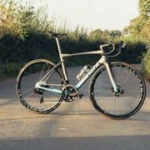Choosing the right bike frame size is paramount for comfort, performance, and injury prevention, whether you’re buying your first bicycle or upgrading to a new model. Understanding how to measure a bike frame empowers you to select a machine that truly fits your body and riding style. This guide will walk you through the essential measurements, ensuring you can confidently assess any bike frame, be it for road cycling, mountain biking, or leisurely commutes.
Essential Tools for Bike Frame Measurement
Before diving into the specifics, gather these simple tools to accurately measure your bike frame:
- Tape Measure: Essential for measuring distances in metric units (centimeters or millimeters) for precision.
- Clinometer App (Smartphone): A free app to measure angles accurately, crucial for head tube and seat tube angles.
- Spirit Level (or Straight Edge with Clinometer App): Ensures horizontal and vertical measurements are precise. A long spirit level is ideal, but a straight piece of wood combined with a clinometer app works effectively.
- Plumb Line (or String and Weight): Helps establish a vertical reference point. You can easily improvise using string and a small weighted object like a nut or washer.
While some manufacturers might still use inches, metric units are the standard for bike frame measurements, offering greater consistency and accuracy. For simplicity, we recommend sticking to metric throughout the measuring process.
Key Bike Frame Geometry Measurements Explained
Understanding these fundamental measurements is key to deciphering bike geometry and ensuring a proper fit:
- Top Tube Length (Effective): The horizontal distance from the center of the head tube to the center of the seat post. This is a crucial measurement for reach and overall bike size.
- Seat Tube Length: The distance from the center of the bottom bracket to the top of the seat tube. While historically used for sizing, it’s less critical now due to varying frame designs.
- Reach: The horizontal distance from the bottom bracket to the top of the head tube. Reach is a primary factor in determining the bike’s overall length and rider position.
- Stack: The vertical distance from the bottom bracket to the top of the head tube. Stack height influences handlebar height and rider posture.
- Wheelbase: The distance between the front and rear wheel axles. Wheelbase affects stability and handling.
- Chainstay Length: The distance from the bottom bracket to the rear axle. Chainstay length impacts handling responsiveness and climbing ability.
- Front Center: The distance from the bottom bracket to the front axle. Contributes to wheelbase and influences weight distribution and handling.
- Seat Tube Angle: The angle of the seat tube relative to the horizontal plane. Affects pedaling efficiency and rider position over the bottom bracket.
- Head Tube Angle: The angle of the head tube relative to the horizontal plane. Influences steering responsiveness and stability.
- Bottom Bracket Drop: The vertical distance from the wheel axles to the bottom bracket. Impacts stability and cornering clearance.
- Bottom Bracket Height: The vertical distance from the ground to the bottom bracket. Affects stability, ground clearance, and center of gravity.
For current bike models, manufacturer geometry charts provide the most accurate measurements. If available for your bike, these charts are invaluable resources and often more precise than manual measurements.
Measuring Top Tube Length Accurately
 Measuring top tube length on a bicycle frame
Measuring top tube length on a bicycle frame
While classic bike frames featured horizontal top tubes, modern designs often incorporate sloping top tubes. For consistent sizing, we measure the effective or virtual top tube length. This represents the horizontal distance between the head tube and seat post centerlines, regardless of the actual top tube slope.
- Horizontal Alignment: Position your spirit level or use your clinometer app and a straight edge to ensure a perfectly horizontal line from the center of the head tube towards the seat post area.
- Measure the Distance: Measure the horizontal distance from the center of the head tube to the point where the horizontal line intersects with the center of the seat post. This measurement is your effective top tube length.
Road bikes are often sized based on top tube length, while mountain bikes commonly use S, M, L sizing. However, sizing conventions vary between brands. A size S from one brand might equal a size M from another, highlighting the importance of understanding specific measurements rather than relying solely on size labels. Even virtual top tube measurements can differ slightly in methodology between manufacturers, so always consider the complete geometry chart for the most accurate comparison.
Step-by-Step Guide to Measuring Seat Tube Length
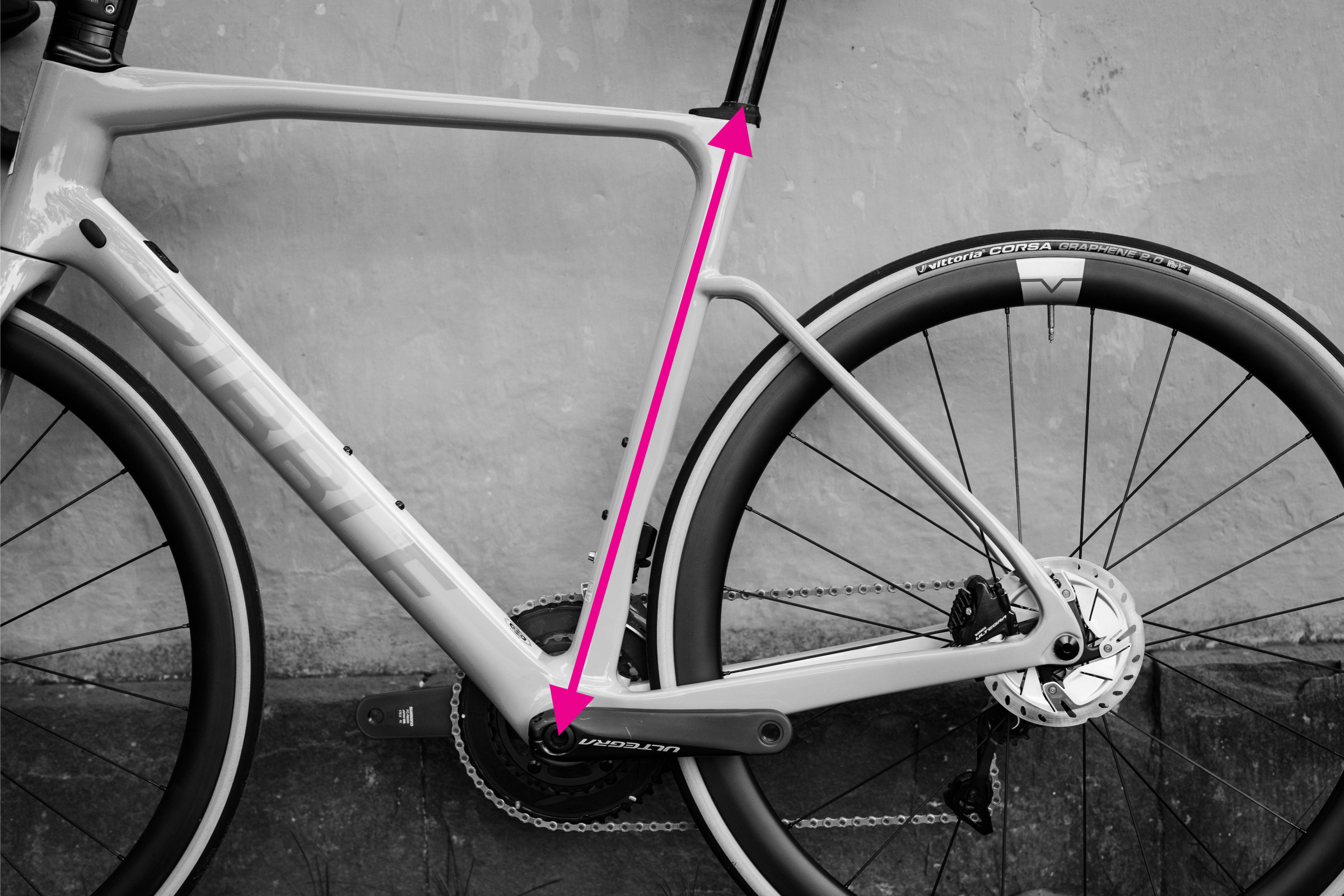 Measuring seat tube length on a bicycle frame
Measuring seat tube length on a bicycle frame
Seat tube length is measured as a straight line from the center of the bottom bracket to the top of the seat tube. However, modern bike designs, such as those with seat mast extensions or kinked seat tubes on mountain bikes, can make this measurement less straightforward for direct comparisons.
- Straight Line Alignment: Visualize or use a straight edge to define a direct line from the center of the bottom bracket to the top of the seat tube. Avoid following the tube’s curve if it’s kinked.
- Measure the Distance: Measure along this straight line from the bottom bracket center to the top of the seat tube. This gives you the seat tube length.
Due to the complexities in seat tube designs, reach and stack measurements are generally more reliable for comparing frame sizes across different models and brands.
Measuring Reach and Stack for Accurate Bike Fit
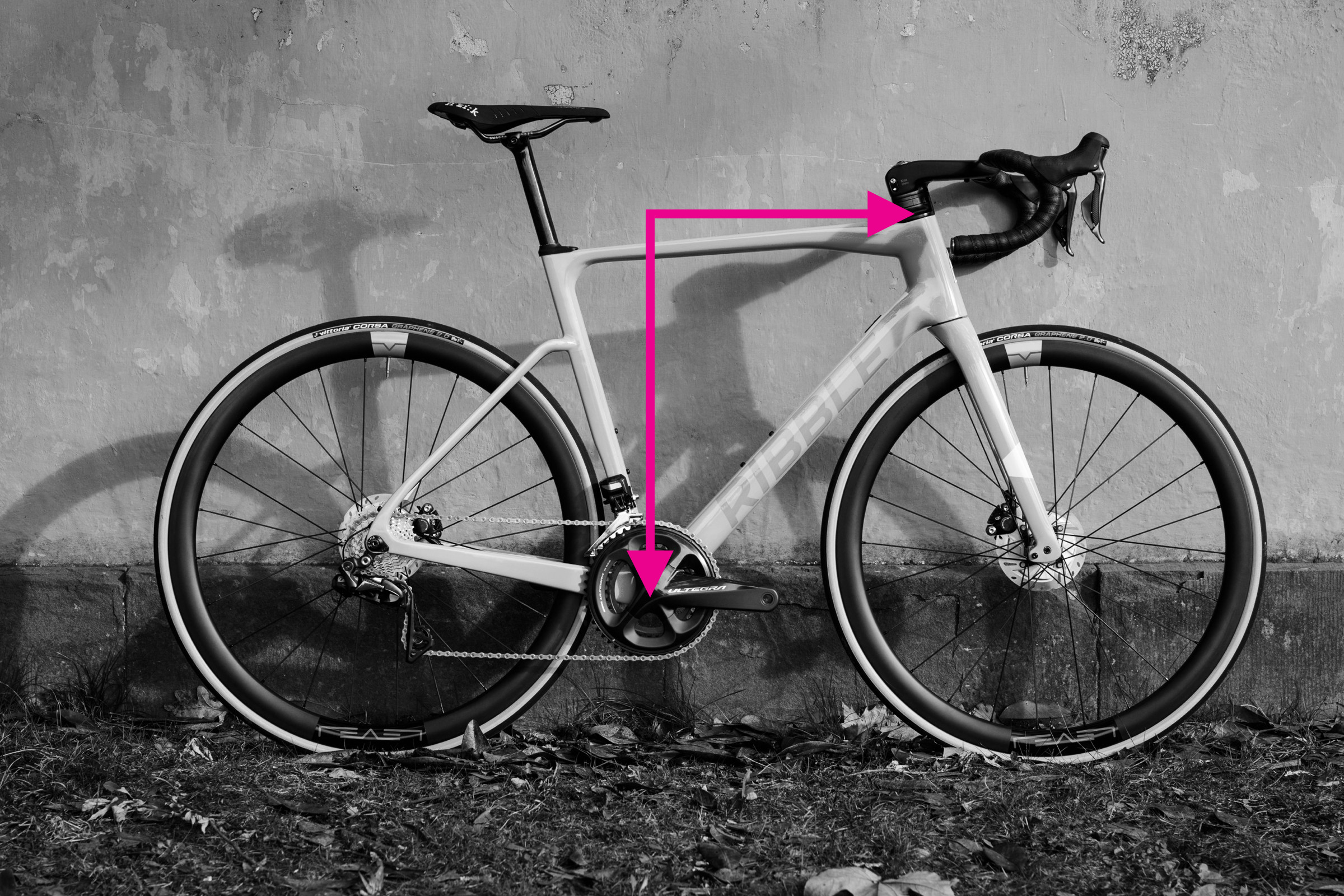 Measuring stack and reach on a bicycle frame
Measuring stack and reach on a bicycle frame
Reach and stack provide consistent and design-independent measurements for comparing bike frames. They represent the perpendicular distances between the bottom bracket and the top of the head tube, two critical contact points on a bike.
Measuring Reach:
- Horizontal Level and Plumb Line Setup: Position your spirit level horizontally at the top of the head tube’s center. Attach a plumb line to the level, ensuring it hangs straight down.
- Align Plumb Line: Adjust the level until the plumb line precisely intersects the center of the bottom bracket spindle.
- Measure Horizontal Distance: Measure the horizontal distance from the plumb line’s starting point on the level to the center of the head tube. This is your reach measurement.
Measuring Stack:
- Vertical Distance: Once your reach measurement setup is in place, measure the vertical distance along the plumb line from the level down to the bottom bracket center. This is your stack measurement.
Alternatively, you can measure the vertical distance from the ground to the top of the head tube and subtract the bottom bracket height from the ground. For accuracy, repeat these measurements, especially reach and stack, as they can be slightly challenging to capture precisely. Having a second person assist can also be helpful when using the plumb line method.
How to Measure Wheelbase Effectively
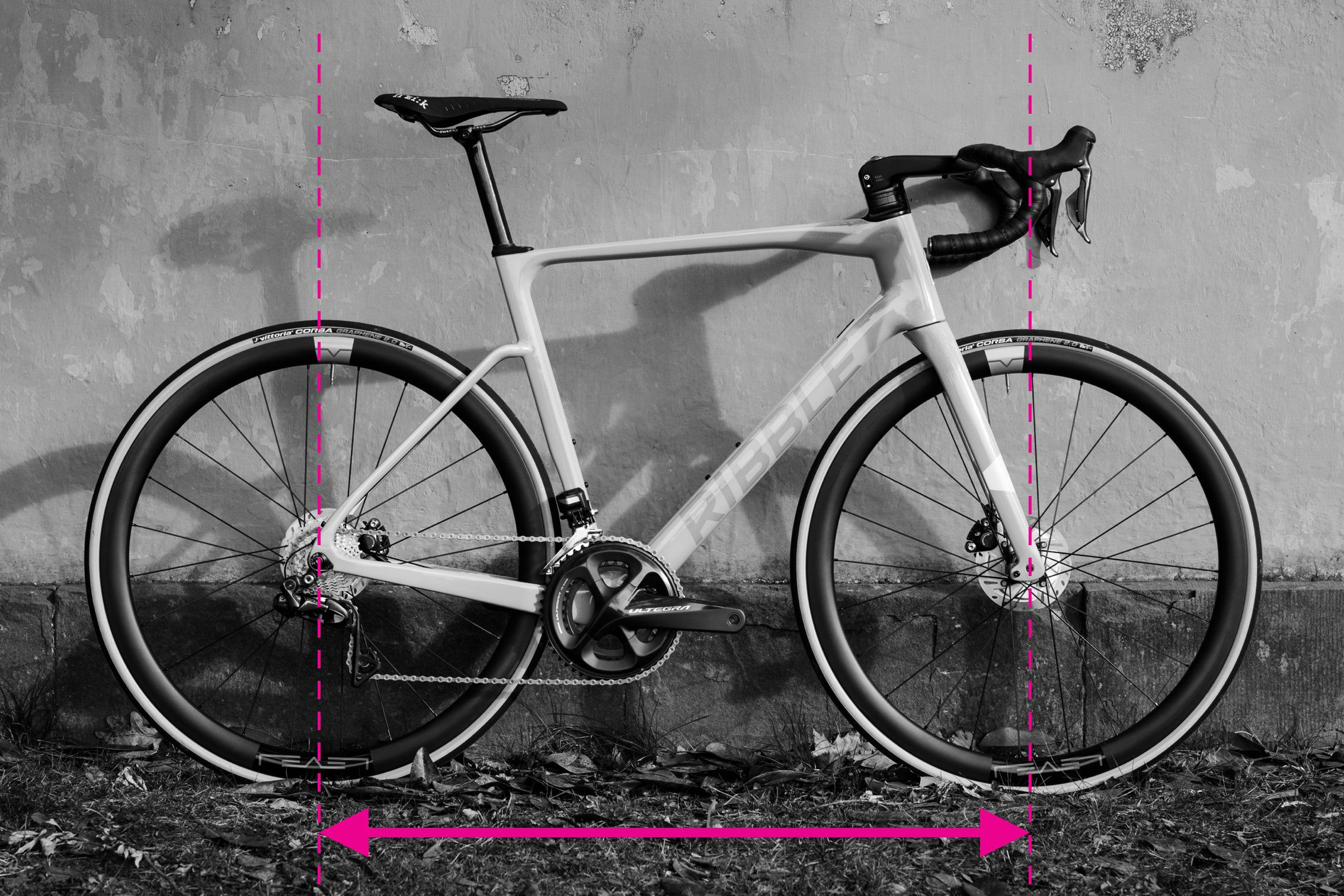 Measuring wheelbase on a bicycle frame
Measuring wheelbase on a bicycle frame
Wheelbase, the distance between the front and rear axle, significantly influences a bike’s ride quality and varies with frame size.
- Straight Fork Alignment: Ensure the front fork is pointing straight ahead. Misalignment will lead to inaccurate measurements.
- Measure Axle-to-Axle Distance: Measure the straight-line distance between the center of the front axle and the center of the rear axle.
For increased accuracy, measure the wheelbase on both sides of the bike and calculate the average to compensate for minor fork misalignments.
Measuring Chainstay Length for Handling Insights
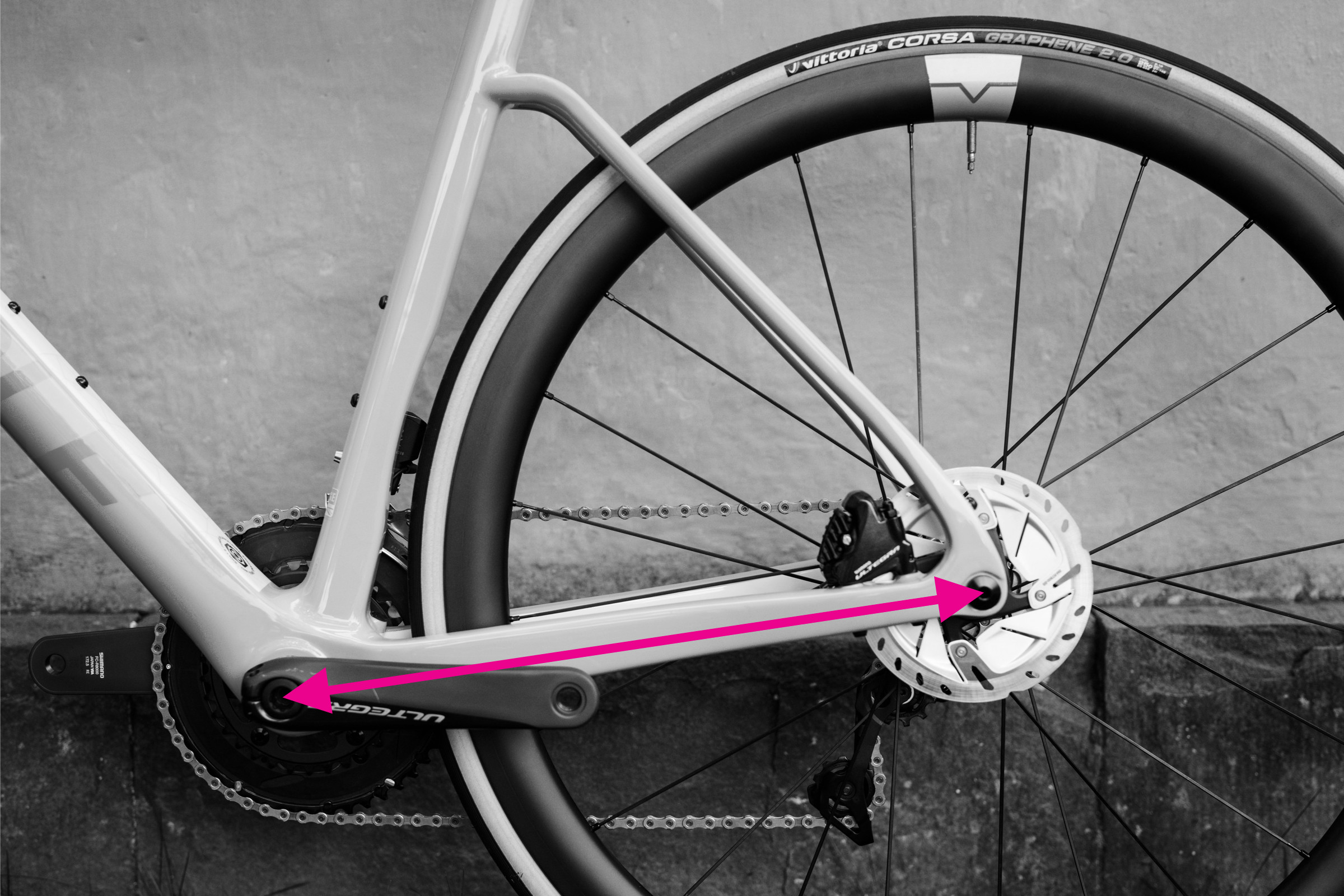 Measuring chainstay length on a bicycle frame
Measuring chainstay length on a bicycle frame
Chainstay length, a component of the wheelbase, greatly affects a bike’s handling characteristics. Shorter chainstays generally result in more agile and responsive bikes.
- Locate Measurement Points: Identify the center of the bottom bracket axle and the center of the rear dropout.
- Measure Straight Distance: Measure the straight-line distance between these two points. This is your chainstay length.
Determining Front Center Measurement
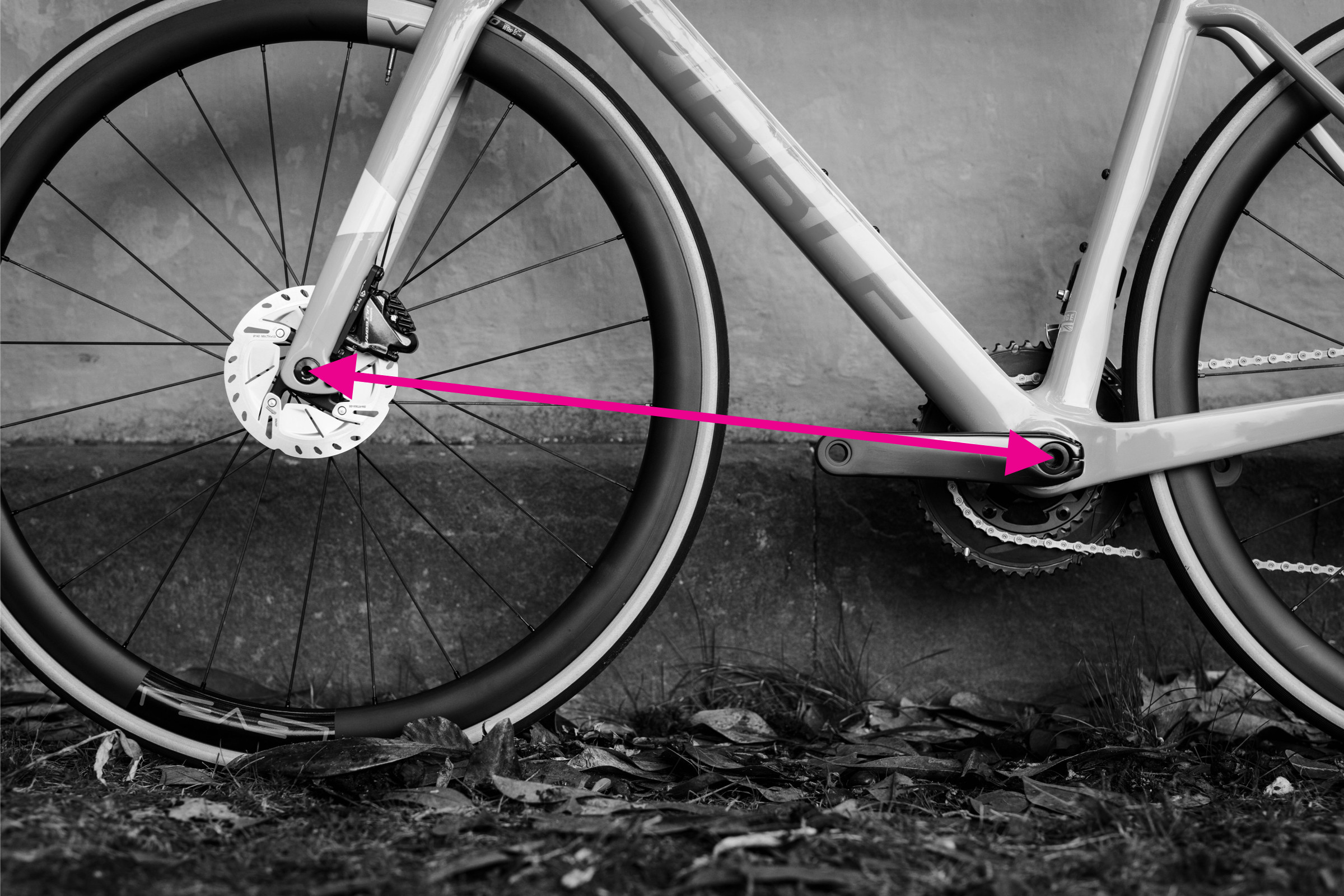 Measuring front center on a bicycle frame
Measuring front center on a bicycle frame
Front center, the other wheelbase component, is the distance from the bottom bracket to the front axle. It influences handling and toe overlap.
- Locate Measurement Points: Identify the center of the bottom bracket axle and the center of the front dropout.
- Measure Straight Distance: Measure the straight-line distance between these two points to find the front center.
While not always listed in geometry charts, front center, along with chainstay length, provides a complete picture of the wheelbase. Note that wheelbase is not simply the sum of chainstay and front center because these measurements are not taken horizontally.
Measuring Seat Tube and Head Tube Angles
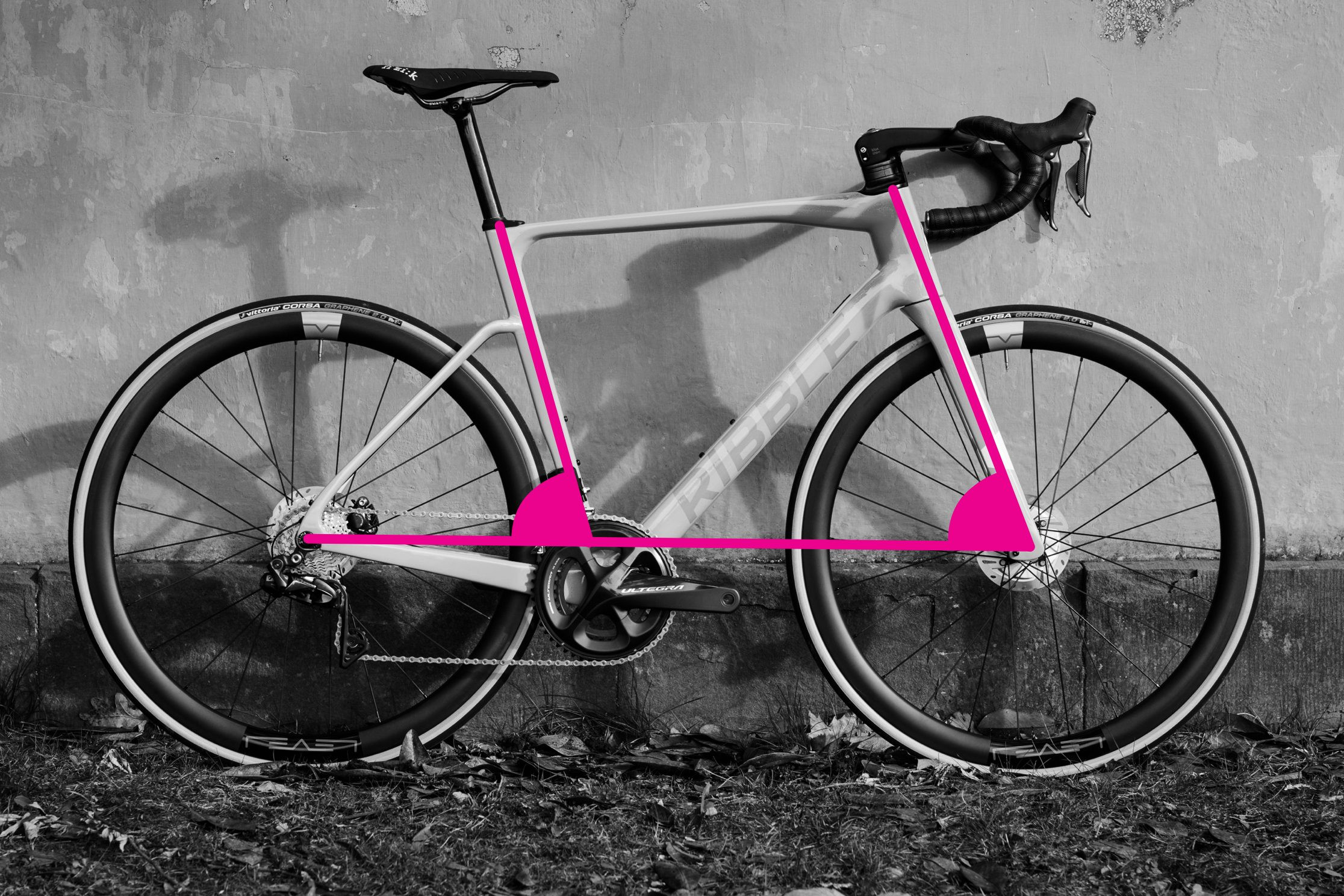 Measuring seat tube and head tube angles on a bicycle frame
Measuring seat tube and head tube angles on a bicycle frame
Seat tube and head tube angles are critical determinants of bike handling. Steeper angles generally lead to quicker, more nimble handling.
Measuring Seat Tube Angle:
- Vertical Bike Position: Ensure the bike is vertical and on a level surface.
- Clinometer Alignment: Place your smartphone with the clinometer app against the seat tube. For straight seat tubes, align directly against the tube. For kinked tubes, use a straight edge to represent the line from the bottom bracket to the top of the seat tube and align the phone against it.
- Read Angle: Read the angle from the clinometer app. This is your seat tube angle.
Measuring Head Tube Angle:
- Vertical Bike Position: Maintain the bike’s vertical position.
- Clinometer Alignment: Align your smartphone or straight edge with the clinometer app along the head tube’s centerline. For tapered head tubes, estimate the centerline or align with the steerer extension above the head tube. Alternatively, for straight fork legs, you can measure the angle of the fork legs as it mirrors the head tube angle.
- Read Angle: Read the angle from the clinometer app. This is your head tube angle.
Determining Bottom Bracket Drop
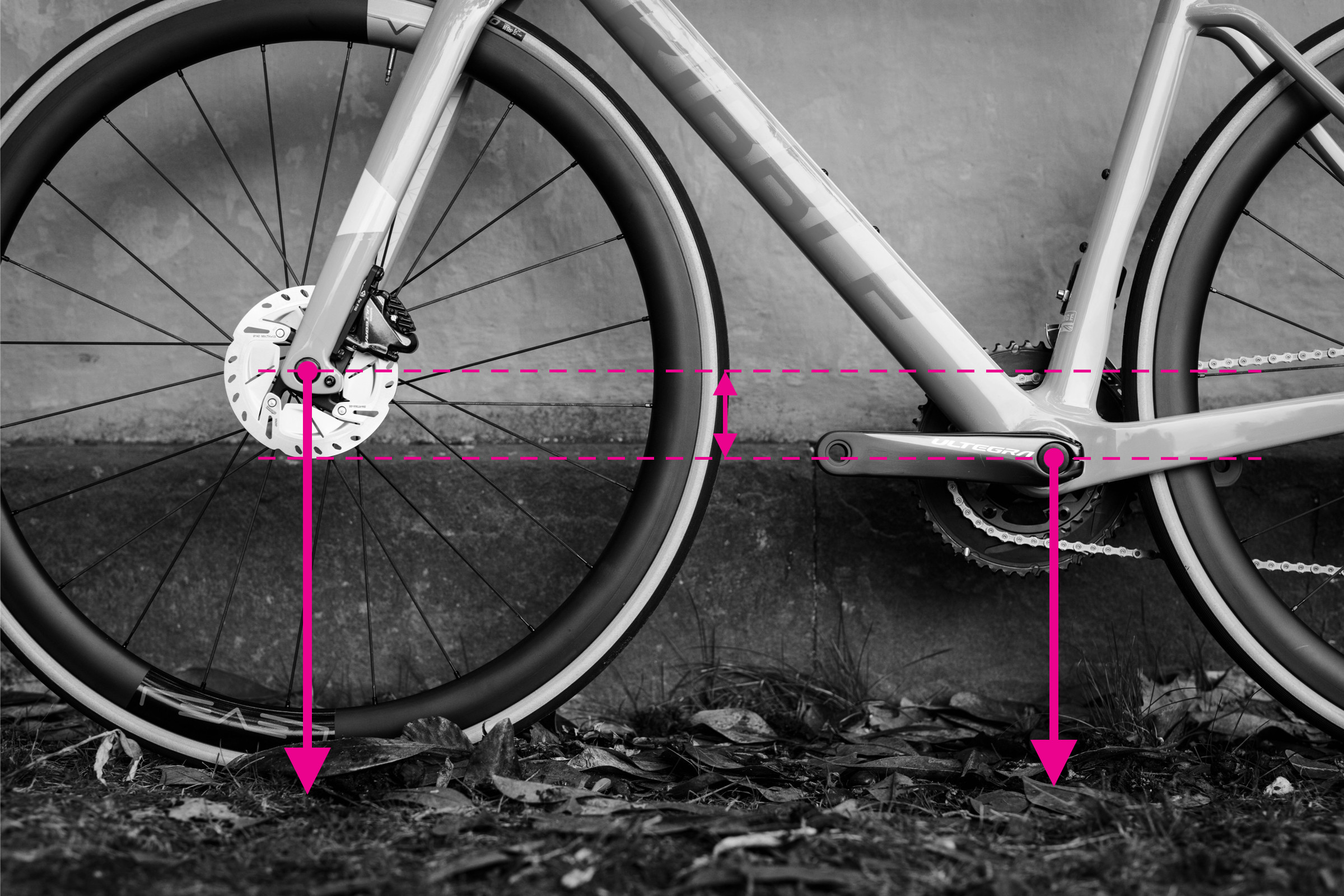 Measuring bottom bracket drop on a bicycle frame
Measuring bottom bracket drop on a bicycle frame
Bottom bracket drop is the vertical distance from the wheel axles to the center of the bottom bracket. It’s a key measurement for stability and handling.
- Measure Rear Axle Height: Measure the vertical distance from the ground to the center of the rear axle.
- Measure Bottom Bracket Height: Measure the vertical distance from the ground to the center of the bottom bracket.
- Calculate the Difference: Subtract the rear axle height from the bottom bracket height. This difference is your bottom bracket drop.
Measuring Bottom Bracket Height
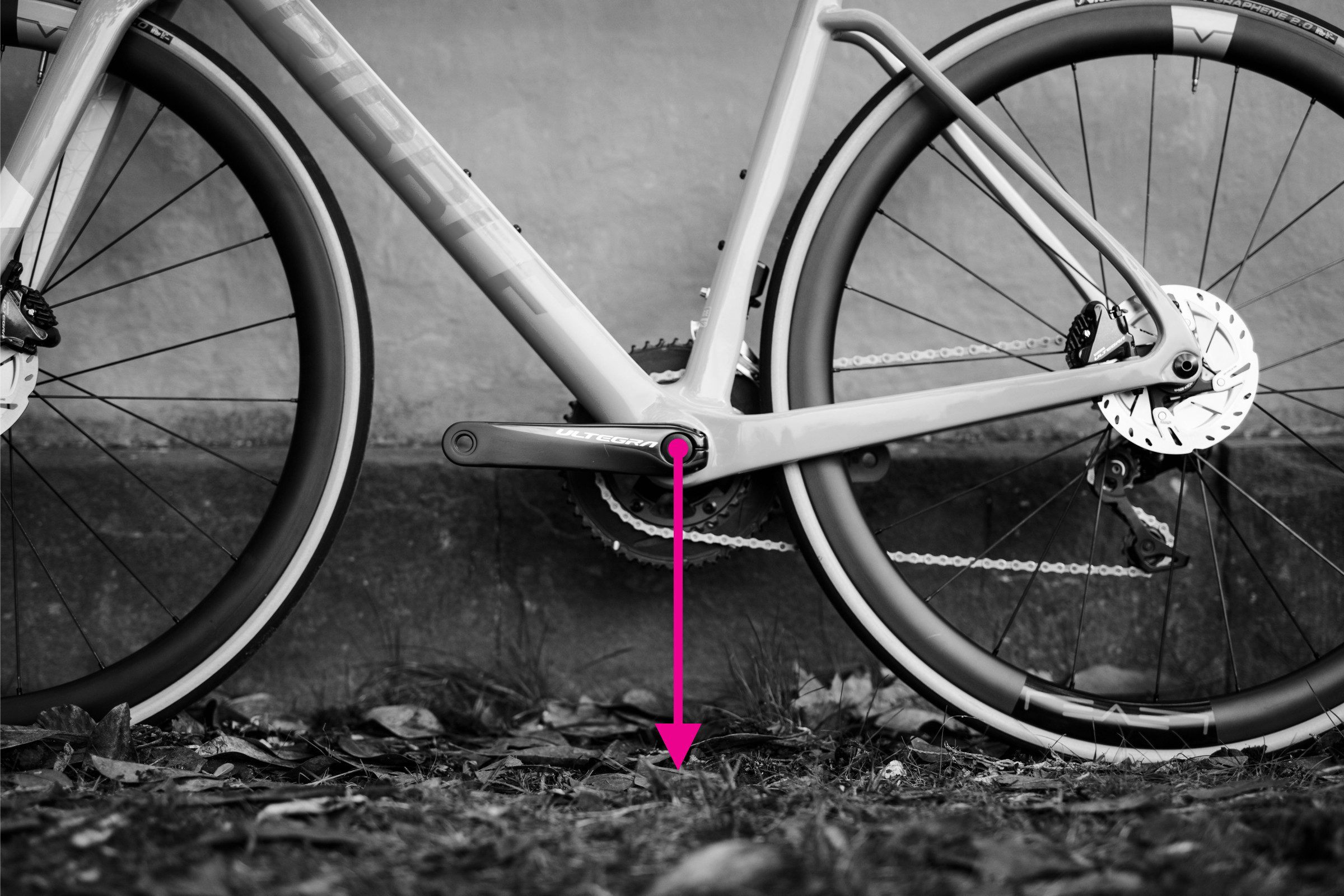 Measuring bottom bracket height on a bicycle frame
Measuring bottom bracket height on a bicycle frame
Bottom bracket height is the vertical distance from the ground to the center of the bottom bracket shell. It influences ground clearance and stability.
- Vertical Bike Position: Ensure the bike is upright on level ground.
- Measure Ground to Bottom Bracket: Measure the vertical distance from the ground to the center of the bottom bracket.
Remember that tire inflation can slightly affect bottom bracket height. Inflate your tires to your typical riding pressure for the most accurate measurement.
Conclusion: Your Bike Frame Measurement Toolkit
By understanding and measuring these key bike frame dimensions, you are now equipped to make informed decisions when purchasing a new or second-hand bike, whether it’s a road bike, commuting bike, or gravel bike. Keep your measurements in a safe place for future reference. This knowledge will ensure you choose a bike frame that fits you perfectly, enhancing your riding experience and performance for years to come.

